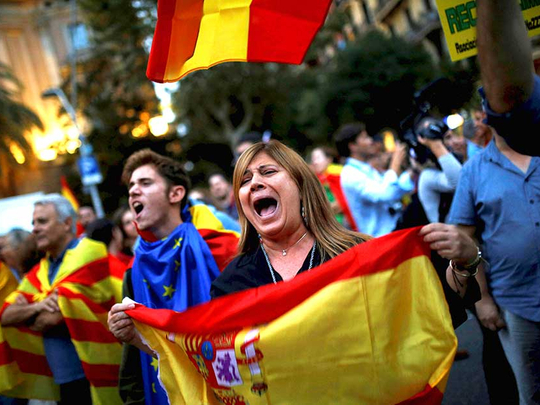
There are good reasons why the Ukrainian Foreign Ministry denounced the Catalan referendum as “illegitimate” while Russian propaganda outlets backed it. The Catalan situation draws comparisons with that in Crimea in 2014, and they are not as easy to dismiss as Catalan independence supporters might think.
To discuss the similarities, let’s first get the one glaring dissimilarity out of the way. In March 2014, the Ukrainian peninsula of Crimea was full of Russian troops, both in and out of uniform. Days after a revolution in Ukraine brought down the government of president Viktor Yanukovych, Russia’s “little green men”, as the unmarked Russian soldiers were called, seized Crimea’s local parliament and installed a local pro-Russian politician, Sergei Aksyonov, as the region’s prime minister.
Ukraine contends that the March 16 referendum, in which Crimea voted to secede from Ukraine and join Russia, took place at gunpoint. That bit, however, is untrue. Neither the “little green men” nor uniformed Russian soldiers were present at polling stations during the vote. There was no armed pressure on Crimeans, not even on the indigenous Crimean Tatars, who didn’t back the secession and mostly abstained from voting, to show up or to fill in ballots a certain way. The presence of Russian troops played a role (more on this later), but it wasn’t what made the referendum illegitimate.
Of course, poor Crimea was only part of Soviet Ukraine since 1954; rich Catalonia has been part of Spain for centuries. Still, eagle-eyed Catalans saw hope in the Crimean referendum. Enrique (Enric in Catalan) Ravello, a right-wing Catalan politician who served as an “observer” at the Crimean referendum, told the New York Times at the time that “Catalonia is for us an example, for what we would like to do”. The Ukrainian constitution, like the Spanish one, doesn’t allow secession. The countries are not federations or unions, like the former union of Sweden and Norway, dissolved in 1905, former Czechoslovakia, dissolved in 1993, the former Soviet Union, whose constitution allowed the constituent republics’ self-determination, or today’s United Kingdom. The Ukrainian government withheld from Aksyonov’s secessionist government access to voter rolls. So it just used any old or incomplete ones it could find. If someone wasn’t on a list, the vote counters simply wrote down their name and gave them a ballot. That allowed an enthusiastic voter to cast multiple ballots.
The Spanish government, too, denied the Catalans access to the rolls. So secessionist Catalan officials told voters to print out ballots at home and cast them wherever they could. Ballots were even handed out at rallies before the referendum.
In Crimea, 95.6 per cent of those who cast votes backed joining Russia. In Catalonia, some 90 per cent did, according to local authorities. In Crimea, the official turnout topped 83 per cent while in Catalonia it reached about half that — but these numbers are equally meaningless because there was no way to ascertain the voting was being held according to any sensible rules. In both Crimea and Catalonia, those who backed secession displayed wild enthusiasm; those who didn’t preferred to keep quiet and stay at home, perhaps out of concern that the enthusiasts might not appreciate their position.
Anyway, it didn’t matter. In Crimea, the secessionist local authorities had already passed a “declaration of independence” by the time the vote took place. In Catalonia, the government of Carles Puigdemont also knew the result well in advance. It plans to declare independence soon.
That’s the most important similarity between the two votes. It doesn’t matter to those who organised them how public opinion really stacked up. They had a goal, and any theatrics that helped them accomplish it were welcome. In the Crimea case, the theatrics included public displays of Russian patriotism (people would cover Ukrainian flags on car license plates with Russian ones); in Catalonia, resistance to Spanish attempts to ban the vote and any sign of Spanish violence were the main themes.
The main difference between Spain-2017 and Ukraine-2014, of course, is that the Ukrainian government simply wasn’t strong enough to impose its laws in Crimea. Subsequent events in the country’s east, when Kiev actually tried to hold secessionist regions by force, confirmed that it would have failed to prevent the secession.
In Spain, Prime Minister Mariano Rajoy heads a minority government, but it isn’t a hastily assembled caretaker cabinet or a weak, post-revolutionary country. It’s in control of its law enforcement apparatus and army and backed in the Catalan matter by its top political rivals and the Spanish king. It’s strong enough to have made an obvious travesty of the secession referendum by harrying its organisers and disrupting the “vote”, and it’ll be strong enough to go after the separatist leaders if they proceed with an independence declaration. It’s also strong enough to reject international mediation; accepting it would be a mistake, a show of weakness against weaker opponents.
Ukraine wants Crimea back — and the world recognises its right to get it back. Spain won’t let Catalonia go peacefully for the same reason, and, for all the moaning about Rajoy’s strong-arm tactics (which haven’t yet included a real crackdown, though), there’s no international support for secession on the strength of the “referendum”.
That’s where the Russian military presence in Crimea comes in. Russia provided the overwhelming force that made the Crimean secession possible in practical terms. The threat of force, and not the referendum, made sure Crimea exists as a de facto part of Russia today. Puigdemont stands alone, without a force that can fight for secession. Even if he had majority public support — which the “referendum” doesn’t allow him to claim — he’d lose a confrontation. That’s why he’s headed for a fall, and the Catalan secessionists will eventually be sent back to the drawing board. If they’re smart, they’ll start working on a long-term campaign to change the Spanish Constitution and turn the country into a federation so self-determination can eventually be discussed.
— Bloomberg
Leonid Bershidsky is a Bloomberg View columnist.










